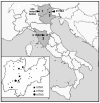First detection of spotted fever group rickettsiae in Ixodes ricinus from Italy
- PMID: 12194779
- PMCID: PMC2732537
- DOI: 10.3201/eid0809.020600
First detection of spotted fever group rickettsiae in Ixodes ricinus from Italy
Abstract
Ixodes ricinus from Italy were examined for the first time to detect whether rickettsiae were present. Using molecular methods, we detected three different spotted fever group rickettsiae, including Rickettsia helvetica. Our results raise the possibility that bacteria other than R. conorii are involved in rickettsial diseases in Italy.
Figures


References
-
- Sekeyova Z, Roux V, Raoult D. Phylogeny of Rickettsia spp. inferred by comparing sequences of ‘gene D’, which encodes an intracytoplasmic protein. Int J Syst Evol Microbiol. 2001;51:1353–60. - PubMed
-
- Tringali G, Intonazzo V, Perna AM, Mansueto S, Vitale G, Walker DH. Epidemiology of Boutonneuse fever in western Sicily. Distribution and prevalence of spotted fever group rickettsial infection in dog ticks (Rhipicephalus sanguineus). Am J Epidemiol. 1986;123:721–7. - PubMed
Publication types
MeSH terms
LinkOut - more resources
Full Text Sources
